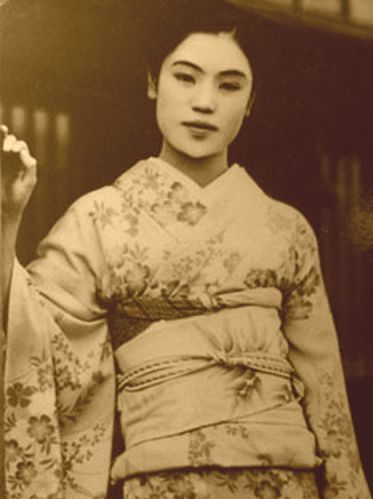
This is Yasunari Kawabata’s mistress and perhaps a model for the hot-springs geisha in his novel Snow Country. But I cannot reconcile this lovely face and her quiet demeanor with the rather brash semi-prostitute in Snow Country. More likely the geisha’s friend, Yoko -- a less developed character in the book -- was based on his lovely mistress.
This photo reminds me of the doll in the tall glass case that graced the office where I first worked in Micronesia, a doll presented sometime in the 1950s to the local island government by the Mitsubishi Company. The tall glass case kept her dust-free, but her once bright kimono and the sprays of wisteria she carried were faded. She, too, was lovely-faced, much as Kawabata’s mistress, and so unlike the modern versions of Japanese dolls I see when I google.
No doubt this doll was my original Mieko. My visual model, that is. Fictional characters do not spring out of mid-air. Fictional characters are a little of this and a little of that, a bit of this real person and a bit of that one, even a bit of someone else’s fictional character. In the case of Meiko, she’s more than a bit of myself -- hard to avoid when employing a first person narrative -- but she is also a bit of the Snow Country geisha, a bit of the refined 10th century court ladies in Murasaki’s Tale of Genji, and perhaps more than a bit of my own East Texas grandmother.
After leaving the Federated States of Micronesia, I moved briefly to Guam and then to Washington, DC, and from there to San Francisco where I took a position with a venerable steamship company (sans the steam). I had gone for interviews with several interesting companies but the reception room of Williams, Dimond had an elegant Japanese doll in a glass case. As I stood there admiring her, a gorgeous Italian ship captain passed through the room and nodded to me.
Williams, Dimond served the shipping lines of many different nationalities, including Mitsui, who had presented the company that doll. The staff was also multi-national -- Russian, Portuguese, Japanese, Korean, Vietnamese, Italian, Mexican, and lots of San Franciscans of Irish descent. Two of Mieko’s fellow brothel workers in Miss Gone-overseas, Chikako and Izumi, were named for two of my favorite co-workers.
And the other characters in Miss Gone-overseas and where they might have sprung from? The governor general was no doubt modeled on my Pohnpeian boss whose office had the good taste to have that doll in the reception room; Mr Uchida for an old love; the young corporal could be my brother, Eric, whose companionship was the joy of my childhood; and Mrs Okata was probably a mixture of all the nuns I had as teachers in all my many grammar schools.
A fictional character has many models, some real, some from dreams, some from characters met in other fictions. But during the actual process of writing and creating characters, I’m quite unaware of my thieving -- from who or from where. Or only vaguely aware.
 newest »
newest »
 newest »
newest »
 Very nice explanation, Mitchell....I suspect this holds true for most authors, a little of this a little of that.
Very nice explanation, Mitchell....I suspect this holds true for most authors, a little of this a little of that.




